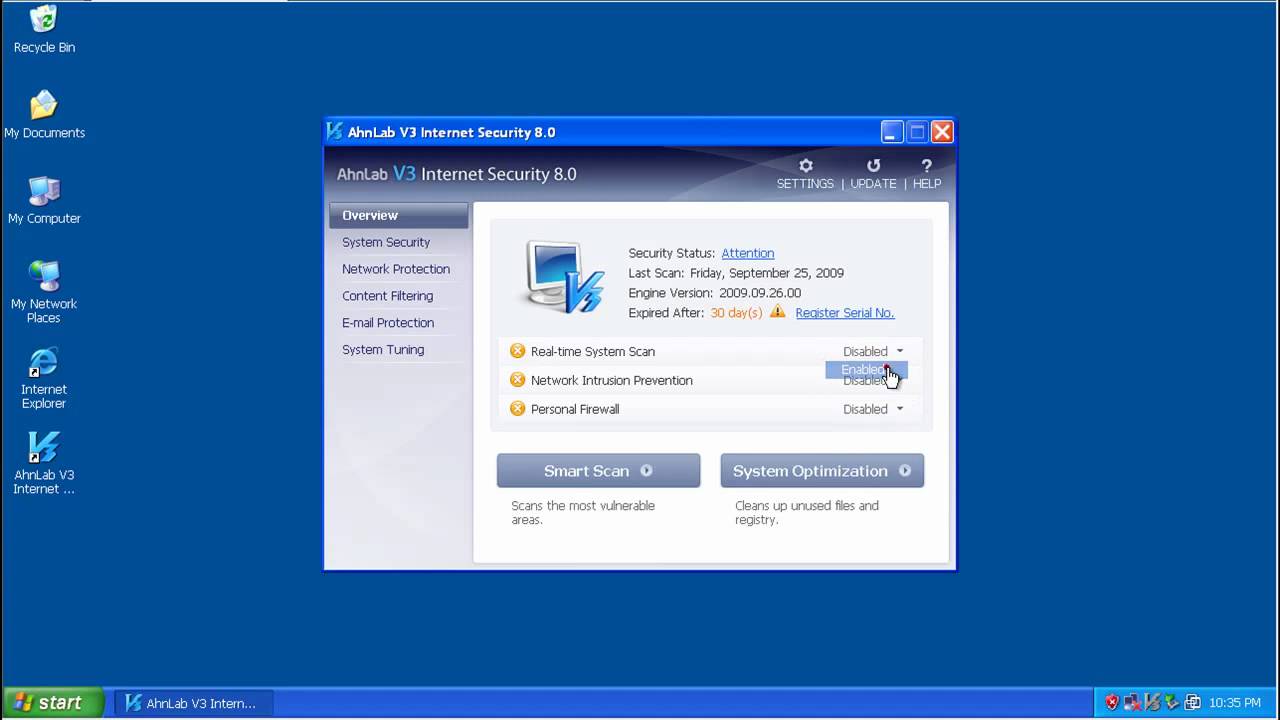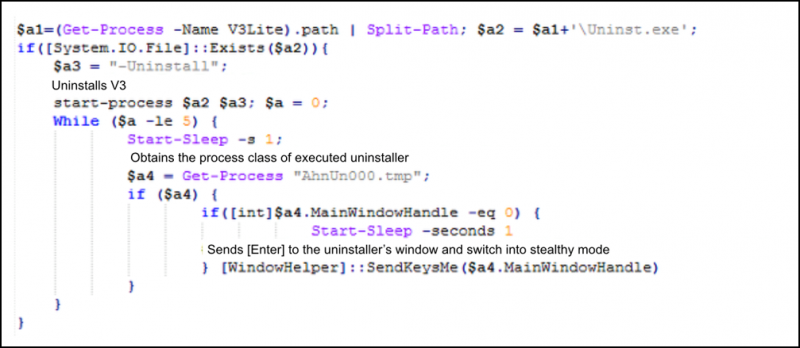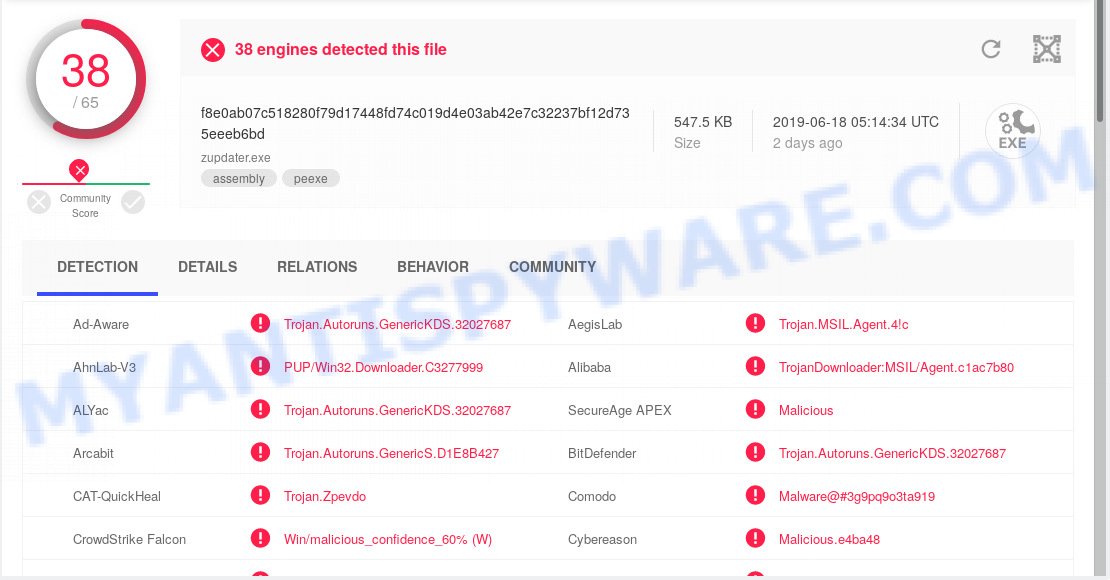Contents
- AhnLab V3 Internet Security 9.0 Version 9.0.47.1237 By AhnLab ...
- Ahnlab V3 - How To Uninstall It And Make It Die Forever?
- Ahnlab Uninstall
AhnLab is one of the engines included in Metascan 4, 8, 12, and 16. AhnLab is changing the way that it is distributing online updates. AhnLab has discontinued the previous method of distributing updates and online updating of AhnLab within Metascan no longer works.
- 1. What is cpatch.exe?
- 2. Is cpatch.exe safe, or is it a virus or malware?
- 3. Can I remove or delete cpatch.exe?
- 4. Common cpatch.exe error messages
- 5. How to fix cpatch.exe
- 6. Update
- 7. Download or reinstall cpatch.exe
- I currently have KIS 2011 and downloaded KIS 2012 to update. I then ran a check about anything on my system which might cause a problem. I got the following message: “In order to install Kaspersky Internet Security 2012 correctly, it is recommended to disable the driver AhnLab Network Filter Driv.
- Jun 22, 2016 A way to uninstall AhnLab Policy Agent 4.6 from your system AhnLab Policy Agent 4.6 is a Windows application. Read below about how to uninstall it from your computer. It was coded for Windows by AhnLab, Inc.
- Jan 04, 2021 Geek Uninstaller is a completely portable program uninstaller that's packed with features, all in a file less than 10 MB in size! Sort programs by their size or installation date, delete entries from the list of software, search through the programs, export a list of installed software to an HTML file, and look up information on any program in the Registry Editor, install folder, or internet.
- AhnLab Safe Transaction How to uninstall AhnLab Safe Transaction from your PC AhnLab Safe Transaction is a Windows program. Read more about how to remove it from your computer. It was coded for Windows by AhnLab, Inc. Check out here for more info on AhnLab, Inc. The program is often placed in the C:Program FilesAhnLabSafe Transaction.

What is cpatch.exe?
cpatch.exe is an executable file that is part of AhnLab Patch Manager developed by AhnLab, Inc.. The Windows XP version of the software: 1.7.2.52 is usually about 142064 bytes in size, but the version you have may differ.
The .exe extension of a file name displays an executable file. In some cases, executable files can damage your computer. Please read the following to decide for yourself whether the cpatch.exe file on your computer is a virus or malware that you should delete, or if in fact it is a valid Windows operating system file or reliable application.
Recommended: Identify cpatch.exe related errors
(optional offer for Reimage - Website | EULA | Privacy Policy | Uninstall)
Is cpatch.exe safe, or is it a virus or malware?
The first thing that will help you determine if a particular file is a legitimate Windows process or a virus, is the location of the executable itself. With cpatch.exe for example, it's path will probably be something like C:Program FilesAhnLab, Inc.AhnLab Patch Managercpatch.exe
To determine it's path, open Task Manager, go to View -> Select Columns and select 'Image Path Name' to add a location column to your Task Manager. If you find a suspicious directory here, it may be a good idea to investigate this process further.
Another tool that can sometimes help you detect bad processes is Microsoft's Process Explorer. Start the program (it does not require installation) and activate 'Check Legends' under Options. Now go to View -> Select Columns and add 'Verified Signer' as one of the columns.
If the 'Verified Signer' status of a process is listed as 'Unable to Verify', you should take a moment look at the process. Not all good Windows processes have a Verified Signature label, but neither do any of the bad ones.
The most important facts about cpatch.exe:
- Name: cpatch.exe
- Software: AhnLab Patch Manager
- Publisher: AhnLab, Inc.
- Expected Location: C:Program FilesAhnLab, Inc.AhnLab Patch Manager subfolder
- Expected Full Path: C:Program FilesAhnLab, Inc.AhnLab Patch Managercpatch.exe
- SHA1: c61cf31d6b02d956cbb3b7bf67622f4800c7564e
- SHA256: 55e375f8b90102ce5876ba399b8530561dfaceee61b4d374f7365d1c82f3c273
- MD5: efbe91c909d25cb8c989e1e52de1daa9
- Known to be up to 142064 bytes in size on most Windows;
If you had any difficulties with this executable, you should determine if it's trustworthy before deleting cpatch.exe. To do this, find this process in Task Manager.
Find its location and compare the size etc with the above facts.
If you suspect that you may be infected with a virus, then you must attempt to fix it immediately. To delete the cpatch.exe virus, you must download and install a full security application like this. Note that not all tools can detect every type of malware, so you may need to try several options before you're successful.
In addition, the functionality of the virus may itself affect the deletion of cpatch.exe. In this case, you must enable Safe Mode with Networking - a secure environment that disables most processes and loads only the most required services and drivers. When there, you can run a security program and a complete system analysis.
Can I remove or delete cpatch.exe?
AhnLab V3 Internet Security 9.0 Version 9.0.47.1237 By AhnLab ...
You should not delete a safe executable file without a valid reason, as this may affect the performance of any associated programs that use that file. Be sure to keep your software and programs up to date to avoid future problems caused by corrupted files. With regard to software functionality issues, check driver and software updates more often, so there is little or no risk of such problems occurring.
The best diagnosis for these suspicious files is a complete system analysis with either ASR Pro or this antivirus and malware remover. If the file is classified as malicious, these applications will also delete cpatch.exe and get rid of the associated malware.
However, if it is not a virus and you need to delete cpatch.exe, then you can uninstall AhnLab Patch Manager from your computer using its uninstaller. If you cannot find it's uninstaller, then you may need to uninstall AhnLab Patch Manager to completely delete cpatch.exe. You can use the Add/Remove Program function in the Windows Control Panel.

- 1. In the Start menu (for Windows 8, right-click the screen's bottom-left corner), click Control Panel, and then under Programs:
o Windows Vista/7/8.1/10: Click Uninstall a Program.
o Windows XP: Click Add or Remove Programs.
- 2. When you find the program AhnLab Patch Manager, click it, and then:
o Windows Vista/7/8.1/10: Click Uninstall.
o Windows XP: Click the Remove or Change/Remove tab (to the right of the program).
- 3. Follow the prompts to remove AhnLab Patch Manager.
Common cpatch.exe error messages
The most common cpatch.exe errors that can appear are:
• 'cpatch.exe Application Error.'
• 'cpatch.exe failed.'
• 'cpatch.exe has encountered a problem and needs to close. We are sorry for the inconvenience.'
• 'cpatch.exe is not a valid Win32 application.'
• 'cpatch.exe is not running.'
• 'cpatch.exe not found.'
• 'Cannot find cpatch.exe.'
• 'Error starting program: cpatch.exe.'
• 'Faulting Application Path: cpatch.exe.'
These .exe error messages can occur during the installation of a program, during the execution of it's associate software program, AhnLab Patch Manager, during the startup or shutdown of Windows, or even during the installation of the Windows operating system. Keeping a record of when and where your cpatch.exe error occurs is important information when it comes to troubleshooting.
How to fix cpatch.exe
A clean and tidy computer is one of the best ways to avoid problems with cpatch.exe. This means performing malware scans, cleaning your hard disk with cleanmgr and sfc /scannow, uninstalling programs you no longer need, monitoring any auto-start programs (with msconfig), and enabling automatic Windows updates. Don't forget to always make regular backups or at least define recovery points.
If you have a bigger problem, try to remember the last thing you did or the last thing you installed before the problem. Use the resmon command to identify the processes that are causing your problem. Even in case of serious problems, instead of reinstalling Windows, you should try to repair your installation or, in the case of Windows 8, by executing the command DISM.exe /Online /Cleanup-image /Restorehealth. This allows you to repair the operating system without data loss.

To help you analyze the cpatch.exe process on your computer, you may find the following programs useful: Security Task Manager displays all Windows tasks running, including built-in hidden processes such as keyboard and browser monitoring or auto-start entries. A single security risk rating indicates the probability that it is spyware, malware or a potential Trojan horse. This anti-virus detects and removes spyware, adware, Trojans, keyloggers, malware and trackers from your hard disk.
Updated :
We recommend you try using this new tool. It fixes a wide range of computer errors, as well as protecting against things like file loss, malware, hardware failures and optimizes your PC for maximum performance. It fixed our PC quicker than doing it manually:

- Step 1 : Download PC Repair & Optimizer Tool (Windows 10, 8, 7, XP, Vista – Microsoft Gold Certified).
- Step 2 : Click “Start Scan” to find Windows registry issues that could be causing PC problems.
- Step 3 : Click “Repair All” to fix all issues.
(optional offer for Reimage - Website | EULA | Privacy Policy | Uninstall)
Download or reinstall cpatch.exe
It is not recommended to download replacement exe files from any download sites, as these may themselves contain viruses etc. If you need to download or reinstall cpatch.exe, then we recommend that you reinstall the main application associated with it AhnLab Patch Manager.
What is AhnLab Patch Manager
| How many licenses? | PM250 SolarWinds Patch Manager PM250 (up to 250 nodes) | $3,750 |
|---|---|---|
| How many licenses? | PM40000 SolarWinds Patch Manager PM40000 (up to 40000 nodes) | $104,995 |
| How many licenses? | PM60000 SolarWinds Patch Manager PM60000 (up to 60000 nodes) | $150,000 |

Operating system information
Ahnlab V3 - How To Uninstall It And Make It Die Forever?
cpatch.exe errors can occur in any of the following Microsoft Windows operating systems:
- Windows 10
- Windows 8.1
- Windows 7
- Windows Vista
- Windows XP
- Windows ME
- Windows 2000
RECOMMENDED: Click here to troubleshoot Windows errors and optimize system performance
Ahnlab Uninstall
Other files in AhnLab Patch Manager:
Other software titles by AhnLab, Inc.:
